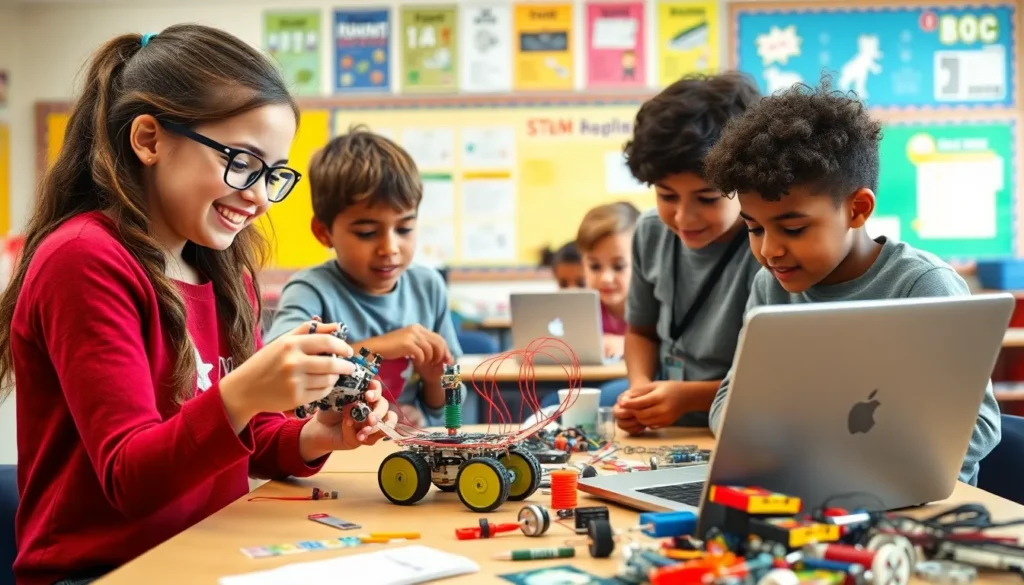Table of Contents
ToggleSTEM education is the secret sauce for sparking curiosity and creativity in young minds. With the right lesson plans, teachers can turn their classrooms into hubs of innovation, where students not only learn but also have a blast doing it. Imagine a world where kids tackle real-world problems through science, technology, engineering, and math while having fun—sounds like a win-win, right?
Overview of Stem Lesson Plans
STEM lesson plans focus on integrating science, technology, engineering, and math to promote critical thinking and problem-solving skills. Effective lesson plans engage students by connecting classroom learning with real-world applications. These plans incorporate hands-on activities that encourage collaboration and creativity.
Teachers design STEM lesson plans to foster an environment where students explore concepts through experimentation. This approach enhances students’ understanding of complex topics while maintaining their interest. Project-based learning features prominently, allowing students to tackle significant challenges and develop solutions.
Key elements of successful STEM lesson plans include clear objectives and measurable outcomes. Assessment methods gauge students’ understanding of the material, providing insights into their progress. Furthermore, lesson plans often adapt to different learning styles, ensuring that all students can participate effectively.
In many cases, digital tools and resources enhance the learning experience. Online simulations and interactive platforms support students as they navigate engineering and technology concepts. By using various tools, educators can create a dynamic and engaging atmosphere that promotes enthusiasm for learning.
Specific examples of activities within STEM lesson plans might include coding exercises, robotics projects, or environmental science experiments. These activities not only convey important principles but also inspire students to pursue careers in STEM fields. Engaging in these lessons often leads to greater retention and a lasting interest in the subjects.
Importance of Stem Education

STEM education plays a crucial role in preparing students for future challenges. By engaging in STEM, learners develop a wide range of essential skills and knowledge that apply to various real-world scenarios.
Benefits for Students
Students benefit from enhanced creativity and critical thinking through STEM exploration. Engaging in hands-on projects fosters collaboration and communication skills. STEM encourages an investigative mindset, empowering children to ask questions and seek solutions. Exposure to real-world issues, like environmental sustainability or technological advancement, motivates students to think critically and innovatively. Increased interest in subjects like math and science enhances overall academic performance and encourages pursuit of STEM-related careers.
Skills Developed Through Stem
Through STEM education, students develop problem-solving and analytical skills. Critical thinking becomes a natural part of their thought process, allowing them to dissect complex challenges effectively. Creativity emerges as they brainstorm unique solutions and build prototypes. Collaboration skills improve as students work in teams to tackle projects, enhancing their ability to communicate ideas. Adaptability becomes essential, encouraging students to pivot when faced with obstacles. These skills prepare them for future academic pursuits and professional environments.
Key Components of Effective Stem Lesson Plans
Effective STEM lesson plans incorporate engaging hands-on learning activities that enable students to grasp complex concepts through direct experience. Activities such as building structures, conducting experiments, and programming robots provide the necessary context for application. These experiences foster collaboration among students, driving them to communicate their ideas and solutions. Furthermore, reflecting on these tasks deepens understanding and retention.
Integration of technology significantly enhances the learning experience. Tools like interactive simulations, coding platforms, and data analysis software immerse students in real-world scenarios. Students engage with technology to solve problems and think critically. Incorporating digital resources allows teachers to adapt lessons based on individual learning preferences. Lastly, leveraging online collaboration tools encourages teamwork, expanding learning opportunities beyond the classroom.
Examples of Stem Lesson Plans
These examples illustrate how STEM lesson plans effectively engage students across different educational levels.
Elementary Level Plans
Hands-on experiments engage elementary students in fundamental concepts. Teachers might implement a plant growth project, where students observe soil types or light exposure effects on growth. Another option includes simple coding exercises using visual programming platforms, introducing coding basics through games. Additionally, bridge-building activities allow students to explore physics principles by constructing models with everyday materials. Exciting group projects encourage collaboration and communication, enhancing teamwork skills.
Middle School Plans
In middle school, projects can tackle more complex topics like environmental science. Students might analyze water quality in local water sources, combining science with mathematics by interpreting data. Robotics competitions provide an excellent opportunity for teamwork and problem-solving, where groups build and program robots to complete specific tasks. Integrating virtual simulations lets students experiment with concepts such as electricity and circuits without physical limitations. Engaging real-world connections deepen understanding and spark curiosity.
High School Plans
High school lesson plans often emphasize advanced concepts in STEM fields. Students could undertake a coding project developing an app, applying math and computer science. Conducting experiments in a physics lab allows exploration of the laws of motion while collecting data to analyze. Additionally, interdisciplinary projects can focus on renewable energy technologies, combining engineering principles with environmental studies. Opportunities like these enhance critical thinking and prepare students for future academic challenges.
Tips for Creating Successful Stem Lesson Plans
Incorporating clear objectives is essential for effective STEM lesson plans. Start by defining what students should learn by the end of each lesson. Design measurable outcomes to track students’ progress and understanding of concepts.
Engagement plays a critical role in capturing students’ attention. Introduce hands-on activities that encourage students to explore and experiment. For instance, building structures or conducting experiments can enhance interest and retention.
Adapting methods for diverse learning styles benefits all students. Consider visual, auditory, and kinesthetic elements to create inclusive experiences. Incorporating digital tools can also enrich the learning environment.
Collaboration strengthens the educational experience. Encourage group projects that promote communication and teamwork. Students often develop problem-solving skills by working together on real-world challenges.
Incorporating technology enhances lesson interactivity. Use online simulations to bring abstract concepts to life. Interactive platforms allow personalized adaptations that cater to individual learning needs.
Setting up a feedback loop provides insight into students’ understanding. Regularly assess and adjust lesson plans based on feedback and outcomes. Continuous improvement ensures lessons remain relevant and effective.
Linking activities to real-world applications deepens comprehension. Relate classroom lessons to current events or community challenges. This connection can motivate students and foster an investigative mindset.
Providing specific examples can inspire creativity. Share successful projects from different educational levels to illustrate potential. Highlighting diverse applications of STEM fields can spark interest in students.
STEM lesson plans play a vital role in shaping the learning experiences of students. By integrating science, technology, engineering, and math, these plans not only enhance academic performance but also cultivate essential skills for future challenges. Engaging activities and real-world applications spark curiosity and creativity, making learning enjoyable and impactful.
Teachers who design effective STEM lesson plans foster an environment where students can explore and collaborate. This approach not only prepares them for STEM careers but also equips them with critical thinking and problem-solving abilities. As the landscape of education continues to evolve, embracing the principles of STEM will remain crucial in nurturing the innovators of tomorrow.







